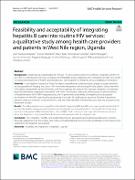| dc.description.abstract | Despite facing a dual burden of HBV and HIV, Africa lacks experience in ofering integrated care for HIV
and HBV. To contextualize individual and group-level feasibility and acceptability of an integrated HIV/HBV care model,
we explored perspectives of health care providers and care recipients on feasibility and acceptability of integration.
In two regional hospitals of West Nile region, we performed a demonstration project to assess feasibility
and acceptability of merging the care of HBV-monoinfected patients with existing HIV care system. Using interviews
with health care providers as key informants, and 6 focus groups discussions with 3 groups of patients, we explored
feasibility [(i)whether integration is perceived to ft within the existing healthcare infrastructure, (ii) perceived ease
of implementation of HIV/HBV integrated care, and (iii) perceived sustainability of integration] and acceptability [whether the HIV/HBV care model is perceived as (i) suitable, (ii) satisfying and attractive (iii) there is perceived
demand, need and intention to recommend its use]. We audio-recorded the interviews and data was analysed using
framework analysis.
The following themes emerged from the data (i) integrating HBV into HIV care is perceived to be feasible, ft
and benefcial, after making requisite adjustments (ii) integration is acceptable due to the need for both free treatment and anticipated collaboration between HIV and HBV clients in terms of peer-support (iii) there are concerns
about the likely rise in stigma and the lack of community awareness about integrated care.
The integrated HIV/HBV care model is feasible and acceptable among both providers and recipients.
Necessary adjustments to the existing care system, including training, for community sensitization on the reasons and
signifcance of integration are required. | en_US |


